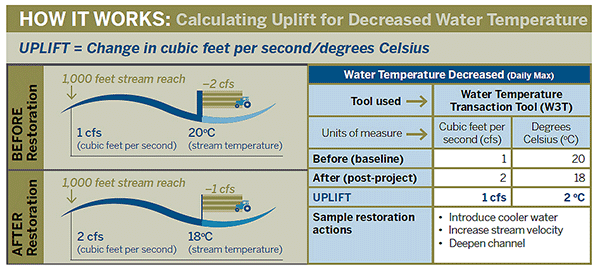Oregon Supports Tool to Estimate Temperature Benefits of Restoring Flow to Rivers
June 25, 2014
Provides a standardized method to quantify temperature reductions for credits
The Oregon Department of Environmental Quality recently voiced its support for the Water Temperature Transaction Tool (W3T), which estimates the thermal benefit of restoring flow to Oregon’s rivers and streams. Developed by Watercourse Engineering, funded by the National Fish and Wildlife Foundation, and in partnership with Willamette Partnership, Farm Stream Solutions and The Freshwater Trust, W3T provides a standardized method of quantifying temperature reductions from flow restoration into credits that can eventually be used to gain regulatory compliance.
“Providing credits for temperature benefits from increasing insteam flow, particularly where additional flow provides multiple environmental benefits, will be helpful throughout the state,” said ODEQ director Dick Pedersen.
Increasing river flow can buffer water temperature and increase velocity through a stream reach. Higher velocity can limit the water’s exposure to local solar impact, keeping the water from warming, an important consideration for supporting the survival of Oregon’s threatened and endangered cold-water fish species.
“W3T is an essential piece of the puzzle in order to focus compliance and public dollars on the actions that most benefit the river and the fish – in this case, additional instream flow,” said Joe Whitworth, President of The Freshwater Trust, a non-profit conservation organization.
Currently, The Freshwater Trust is testing W3T on flow restoration projects in the John Day, Hood and Grande Ronde basins to develop protocols necessary to translate the benefits into discrete tradable units – or credits – that regulated entities such as wastewater treatment plants can use to meet regulatory requirements.
“We look forward to incorporating the Water Temperature Transaction Tool and applicable elements of the insteam flow crediting protocol into DEQ’s water quality trading program,” continued Pedersen.
Beyond its use in credit markets, W3T can aid resource managers in decision-making by quickly predicting whether there might be negative temperature impacts associated with flow transactions such as point-of-diversion transfers or other actions proposed in permit applications.
“It’s hard to get good water quality if there’s no water in the stream. As a decision support tool, W3T helps landowners and others understand how flow transactions translate into improved conditions for fish and for people,” said Bobby Cochran, Executive Director of Willamette Partnership.
# # #
About The Freshwater Trust
The Freshwater Trust is an action-oriented 501(c)(3) not-for-profit that restores rivers and streams throughout Oregon. The Freshwater Trust uses technology, data, and cooperative, market-based solutions that benefit rivers, working lands and local communities. From working with landowners to keep more water in streams to streamlining restoration processes to improving aquatic habitat using a localized approach, the organization is dedicated to accelerating the pace and scale of quantified environmental restoration in order to achieve environmental gains on a timeline that matters.
About Willamette Partnership
Willamette Partnership is a nonprofit coalition dedicated to expanding the pace, scope, and effectiveness of conservation throughout the Willamette and other parts of the western United States. Its focus on incentives and market-based conservation helps change how we value nature in a way that links healthy economies with a healthy environment.
#Conservation #engineering #flow restoration #freshwater fish #Grande Ronde Basin #Hood Basin #John Day #National Fish and Wildlife Foundation #Oregon #Oregon Department of Environmental Quality #Quantified #restoration projects #rivers #streams #thermal credits #water temperature #Water Temperature Transaction Tool

